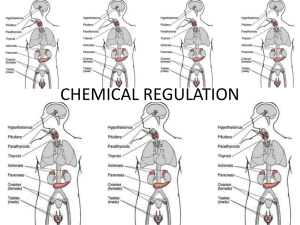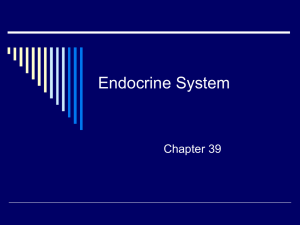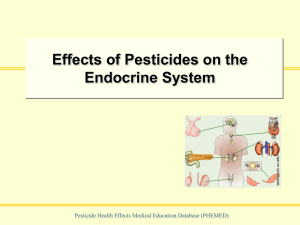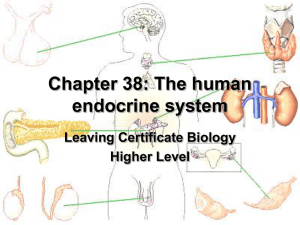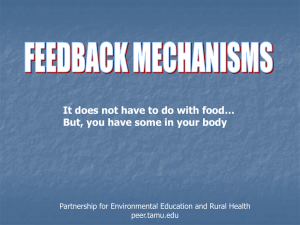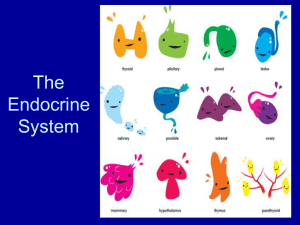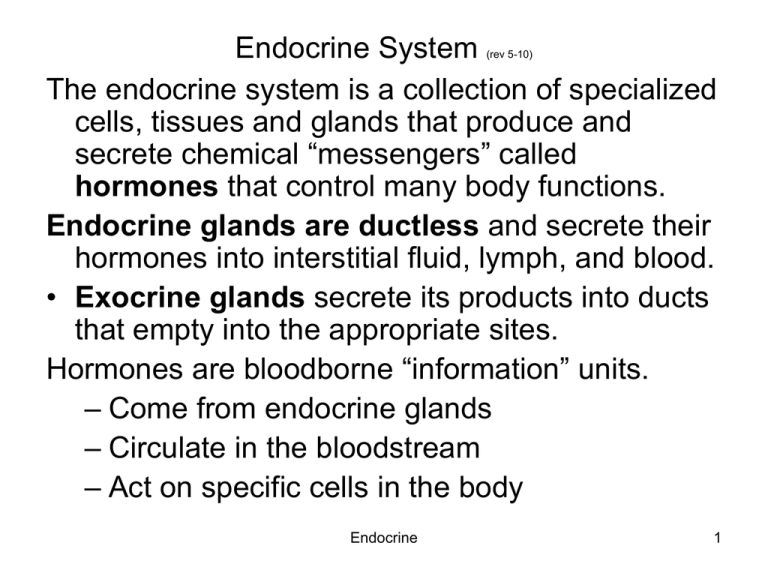
Endocrine System
The endocrine system is a collection of specialized
cells, tissues and glands that produce and
secrete chemical “messengers” called
hormones that control many body functions.
Endocrine glands are ductless and secrete their
hormones into interstitial fluid, lymph, and blood.
• Exocrine glands secrete its products into ducts
that empty into the appropriate sites.
Hormones are bloodborne “information” units.
– Come from endocrine glands
– Circulate in the bloodstream
– Act on specific cells in the body
(rev 5-10)
Endocrine
1
•
Endocrine glands are stimulated in one of
three ways:
1. By nervous impulses (usually from the
hypothalamus)
2. By hormones (usually from the
hypothalamus or anterior pituitary)
3. By humoral stimulation (usually a chemical
[glucose, calcium] )regulated by the
hormone which activates or inhibits hormone
release
Endocrine
2
Endocrine System Characteristics
• Access to every cell because hormones circulate
in the blood
• Each hormone acts only on specific cells (target
cells) because only the hormone’s target cells
have the appropriate receptor to fit it;
• Endocrine control slower than nervous system
• Endocrine and nervous systems interact i.e.
timing of growth and sexual maturation involves
a complex sequence of changes in both
endocrine and nerve signals; release of some
hormones is dependent on input from sensory
neurons.
Endocrine
3
Classification of Hormones
• Hormones are classified as “steroid” or “nonsteroid”
based on their structure and mechanism of action.
• Steroid hormones:
– Lipid soluble, chemically derived from cholesterol
– Enter target cells, bind to an intracellular receptor
and activate genes that produce new proteins
– Slower acting than nonsteroid hormones; minutes
to hours depending on how long it takes to
produce a new protein
Endocrine
4
Steroid hormones pass through the plasma
membrane and act in a two step process.
Once inside the cell, steroid hormones
bind to the nuclear membrane receptors,
producing an activated hormone-receptor
complex. The activated hormone-receptor
complex binds to DNA and activates
mRNA to produce new proteins.
Endocrine
5
• Nonsteroid hormones:
– Water soluble; derived from amino acid protein building
blocks
– Bind to receptors on target cell membranes to convert
an inactive molecule within the cell into an active
molecule. The activated molecule produces a chemical
which is called a second messenger.
– Work through intermediate mechanisms to activate
existing enzymes so that even a small amount of
hormone can produce a significant cellular change
– Faster action than steroid hormones, seconds to
minutes
Endocrine
6
Homeostasis is generally maintained by a negative
feedback loop.
In a negative feedback loop involving a hormone,
the endocrine gland is the control center, the
hormone represents the pathway between the
control center and the effectors, the hormone’s
target cells, tissues, or organs.
• An endocrine system negative feedback loop is a stable,
self-adjusting mechanism for maintaining homeostasis of
the controlled variable because any change in the
controlled variable causes a response that reverses that
change.
Endocrine
7
Hypothalamus and the Posterior Pituitary Gland
The hypothalamus
– plays an important role in the regulation of
homeostasis. (It monitors fluid and electrolyte
balance, temperature, and carbohydrate metabolism.)
– Also produces hormones
– Hypothalamic hormones stimulate the release of most
pituitary hormones
• Has specialized neuroendocrine cells which
function as both nerve and endocrine cells;
they generate nerve impulses and release
hormones into the blood vessels; called the
neuroendocrine reflex
• Monitors the pituitary
gland
Endocrine
8
– Releasing hormones from the hypothalamus
are actually neurosecretions
– Interaction between the hypothalamus and
the pituitary demonstrates the relationship
between the endocrine and the nervous
systems
– Is physically connected to the hypothalamus
by a thin strip of tissue called the infidibulum
9
Endocrine
Pituitary Gland (also called hypophysis)
– Called the “master gland” because it
secretes 8 different hormones which regulate
many of the other endocrine glands;
– Consists of 2 lobes: posterior and anterior
1. Posterior pituitary (lobe):
– Neuroglial-like supporting cells and nerve
fibers
2. Anterior pituitary (lobe) (adenohypophysis)
– Glandular tissue
10
Endocrine
Posterior pituitary:
– Connection to hypothalamus: hormones made in
hypothalamus, stored in posterior pituitary
– Hormones: nonsteroidal; made by
neuroendocrine cells
• Antidiuretic hormone (ADH): causes
reabsorption of water in kidneys, regulates
water balance in body
• Oxytocin: causes uterine contractions during
labor and milk ejection
Endocrine
11
Hypothalamus and the Anterior Pituitary Gland
• Anterior pituitary:
– Releasing and inhibiting hormones from the
hypothalamus travel to anterior pituitary through
the pituitary portal system--a special blood
supply that runs directly between the
hypothalamus and the anterior pituitary. Even
though the amount of these hormones is tiny,
the concentrations are enough to stimulate the
anterior pituitary gland cells
Endocrine
12
Hypothalamus and the Anterior Pituitary Gland
– Hormones: nonsteroidal:
• Adrenocorticotropic hormone (ACTH):
stimulates adrenal cortex
• ACTH-Adrenocorticotropic Hormone
–Stimulates the adrenal cortex to release
glucocorticosteroids (steroid hormones
involved in stress related conditions and the
metabolism of glucose)
– TSH-Thyroid Stimulating Hormone
• Stimulates the thyroid gland to produce
thyroid hormone
Endocrine
13
Hypothalamus and the Anterior Pituitary Gland
– Follicle stimulating hormone (FSH): induces
egg development and sperm development
– Luteinizing hormone (LH): promotes ovulation
and testosterone. These hormones are absent
until ages 10-13 years and their production
stimulates sexual maturation and development
of the secondary sexual characteristics
– Prolactin (PRL): stimulates the development of
mammary gland cells and production of milk
– Growth hormone (GH): widespread effects on
growth
Endocrine
14
Pituitary Disorders
Endocrine disorders tend to be chronic conditions
of hypersecretion (too much hormone) or
hyposecretion (too little hormone)
• Syndrome of inappropriate ADH secretion
(SIADH): hypersecretion of ADH, excessive
water retention so the body is out of balance—
symptoms: headache, vomiting
• Diabetes insipidus: hyposecretion of ADH,
inability to save water appropriately; frequent
urination
Endocrine
15
Pituitary Disorders
• Gigantism: hypersecretion of growth hormone
during childhood and adolescence; usual cause
is a tumor of the anterior lobe of the pituitary.
Person has relatively normal body proportions
• Acromegaly: hypersecretion of growth hormone
in adulthood; overgrowth of hands, feet and face
• Pituitary dwarfism: hyposecretion of growth
hormone during childhood; immediate treatment
with growth hormone during childhood
Endocrine
16
Pancreas: Endocrine Functions
Pancreas is both an endocrine gland and an
exocrine gland (secreting products into the
digestive tract)
Endocrine cells are located in the Islets of
Langerhans; clusters of cells throughout the
pancreas
• Hormones: nonsteroidal: all work to regulate
blood sugar
– Glucagon: made by alpha cells; raises blood sugar
– Insulin: made by beta cells, lowers blood sugar
– Somatostatin: made by delta cells, inhibits secretion
of glucagon and insulin, regulates other hormones
Endocrine
17
Disorders of the Endocrine System
Since the endocrine system is one of 2 primary
systems for controlling body functions, any
disruption can have a widespread effect
Diabetes mellitus: DM—poor control of blood
sugar resulting in an inability to get glucose into
cells so the glucose stays in the circulatory
system and overwhelms the kidney’s ability to
resorb the sugar so it gets excreted in the urine.
Because of the high level, the person also
excretes a large amount of water and thus goes
to the bathroom extremely frequently.
Endocrine
18
– Person becomes dehydrated and very thirsty,
tired, has blurred vision, frequent infections,
slow healing cuts, tingling in feet and hands.
When glucose can’t be metabolized correctly, the
body will metabolize fat and proteins. This
causes other problems—cardiovascular and
neural diseases, renal failure, blindness, and
potentially leg amputations.
Endocrine
19
• There are 2 types of diabetes:
– Type I -caused by the failure of the pancreas
to secrete enough insulin possibly caused by
a virus that causes the immune system to
attack the beta cells of the pancreas
• Person is insulin dependent for the rest of
his/her life
Endocrine
20
– Type II -thought to be insulin resistance—
cells fail to respond adequately to insulin even
when present
• Usually occurs in adults over 40 years
• Treatment: lifestyle changes
• Oral pills: drugs to stimulate the pancreas
to secrete more insulin; drugs that increase
the uptake of glucose by the liver and
muscle cells
• New: inhalable insulin
Endocrine
21
Adrenal Glands
Adrenal glands are located just above the kidneys
– Have an outer layer—cortex and an inner
layer--medulla
• Adrenal cortex:
– Secretion: mediated through hypothalamuspituitary secretions
– Hormones: steroidal
Endocrine
22
Adrenal Gland-Cortex
– Glucocorticoids: cortisol assists glucagon in
maintaining glucose levels during prolong fasting
by promoting using fats and amino acids (liver
can use amino acids to make glucose) AND
• Suppresses inflammation after infection or
injury
• Also secreted when we are under emotional
stress
– Mineralocorticoids: aldosterone--primarily
regulates minerals (sodium and potassium)
• Also helps maintain body water balance
Endocrine
23
Adrenal Gland: Medulla
• Adrenal medulla: neuroendocrine organ (when
these are released into blood stream, funtion as
hormones; when work as neurotransmitters, are
nervous system transmitters
– Secretion: sympathetic nervous system
– Hormones: nonsteroidal:
• Epinephrine and norepinephrine: enhance
function of sympathetic nervous system (fightor-flight response)
• Play role in metabolism and controlling blood
pressure and heart activity
Endocrine
24
Adrenal glands:
• Addison’s disease: failure of adrenal
cortex to secrete sufficient cortisol and
aldosterone
• Lack of cortisol decreases blood sugar
levels
• Lack of aldosterone lowers blood sodium
levels
• Symptoms: fatigue, weakness, abdominal
pain, weight loss
• Treatment is medicine to replace hormones
Endocrine
25
• Cushing’s syndrome: excessive cortisol
production causing
– Excessive production of glucose and retention
of too much salt and water.
– Blood sugar rises and muscle mass
decreases because protein is used to make
sugar. Some glucose is converted to fat but
in specific areas of the body—the face,
abdomen and back of the neck (a hump of fat
can be seen by the neck)
– Symptoms include weakness, fatigue, edema
and high blood pressure
Endocrine
26
Thyroid Gland
Located below larynx at the front of the trachea.
• Functionally linked to the parathyroid gland.
Both help regulate calcium balance.
Thyroid gland helps control metabolism.
• Secretion: mediated through hypothalamus–
pituitary secretions
• Steroidal hormones:
– Thyroxine (T4) and Triiodothyronine (T3):
both regulate production of ATP from
glucose, affect metabolic rate
Endocrine
27
Thyroid Gland
Iodine deficiency causes decrease in production of
thyroid hormones
• This causes goiter which is a result of the failure of the
feedback inhibition of production of TRH and TSH.
– Hypothalamus secretes thyrotropin releasing hormone (TRH)
which stimulates your pituitary to release TSH.
– TSH stimulates the thyroid to make thyroid hormones.
– TSH causes increase in size of thyroid gland as a result of the
gland trying to produce more hormones which it can’t do
because of lack of iodine
• Calcitonin: decreases rate of bone resorption
– lowers blood calcium levels by stimulating the intake of
calcium by bone and increasing bone mass
• Especially important for the development of bones in
children
Endocrine
28
Disorders of the Endocrine System
Thyroid:
– Hyperthyroidism: overactive thyroid gland;
hyperactivity, nervousness, agitation and
weight loss
• Graves’ disease: an autoimmune disease
in which the person’s antibodies stimulate
the thyroid to produce too much thyroxine.
Accompanied by protruding eyes (called
exopthalmos, caused by fluid accumulation
behind the eyes)
Endocrine
29
Disorders of the Endocrine System
Thyroid:
– Hypothyroidism: underactive thyroid gland
slows body growth, changes brain
development, delays the onset of puberty
• Children: cretinism—mental retardation and
stunted growth
• Adults: myxedema—swelling under the
skin, lethargy, weight gain, low body
temperature
Endocrine
30
Parathyroid Glands
Located in the back of the thyroid gland
• Hormone: parathyroid hormone (PTH),
nonsteroidal:
– Removes calcium and phosphate from bone
– Increases absorption of calcium by the
digestive tract
– Increases retention by the kidneys of calcium
and excretion of phosphate
• PTH increases the calcium concentration in the
blood and is secreted in response to lowered
blood calcium levels
Endocrine
31
Reproductive Hormones
The gonads (testes and ovaries) are responsible for the
production of sperm and eggs and production of the sex
hormones.
The testes, located in the scrotum, produce androgens, the
male sex hormone.
• Hormone: in males: the androgen testosterone
(steroidal):
– Functions:
• Regulates development and normal functioning of
sperm, male reproductive organs, male sex drive
• Development of male secondary sex
characteristics and bone and muscle growth at
puberty
Endocrine
32
Ovaries
• Hormones (steroidal) and functions:
– Estrogen: initiates development of secondary
sex characteristics, regulates menstrual cycle
– Progesterone: regulates menstrual cycle
Endocrine
33
Other Hormone Sources
• Thymus: thymosin and thymopoietin, assist
maturation of T lymphocytes (non-steroidal hormone)
• Pineal gland: melatonin
– Receives input from the eyes; melatonin secretion is
higher in the dark; important in synchronizing the
body’s rhythms to the daily light/dark cycle (Circadian
cycle or rhythm)
• Heart: atrial natriuretic hormone (ANH) (nonsteroidal hormone); secreted by the atria to help
regulate blood pressure by increasing the rate at
which sodium and water are excreted in urine thus
decreasing blood volume
Endocrine
34
Other Hormone Sources
• Digestive system: gastrin, secretin,
cholecystokinin; they stimulate activities of the
stomach, pancreas and gallbladder
• Kidney: Erythropoietin stimulates RBC
production
– Renin stimulates aldosterone secretion and
constricts blood vessels
Endocrine
35
Other Chemical Messengers
Function in ways similar to hormones but aren’t
secreted directly into the bloodstream.
– Actions of these are primarily local
– Actions short because they are either quickly
destroyed or reabsorbed by the cells that produced
them
• Histamine: inflammation
– Mast cells release into local interstitial fluid in
response to tissue injury or allergen presence
• Histamine increases local mucus secretion, dilates
blood vessels and increases the leakiness of
capillaries
Endocrine
36
• Prostaglandins: local control of blood flow;
– Can constrict and dilate blood vessels depending on
what is needed; contribute to the inflammatory
response; involved in blood clotting at injury site
• Nitric oxide: multiple functions
– Regulates local blood flow, regulating smooth muscle
contraction in the digestive tract; fights bacteria,
interferes with clotting mechanisms
• Growth factors: local acting to modify development
of specific tissues; influence when a cell will divide
Endocrine
37




